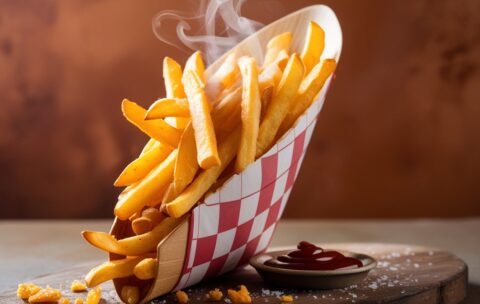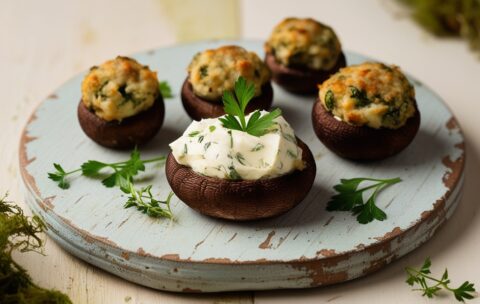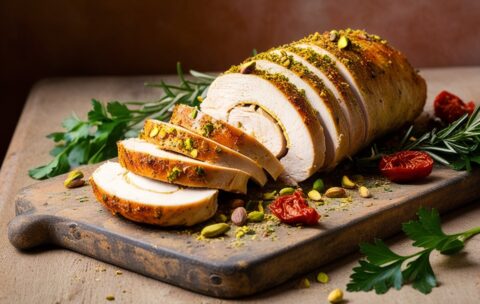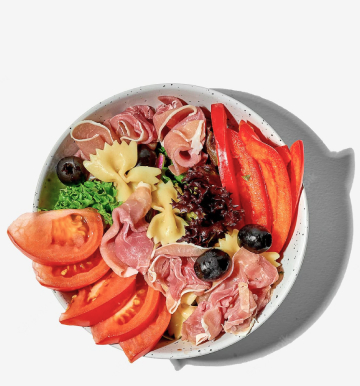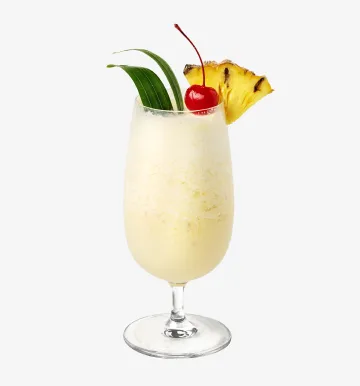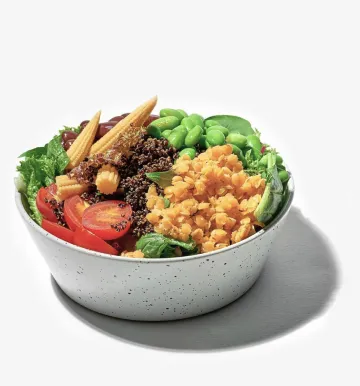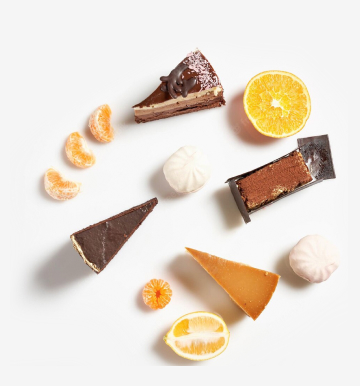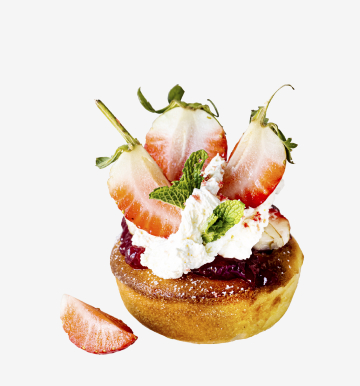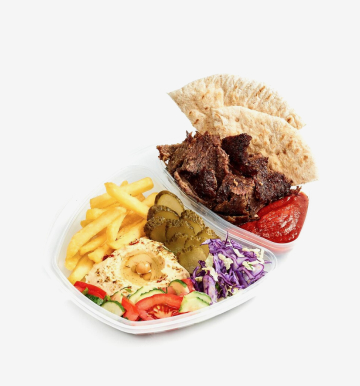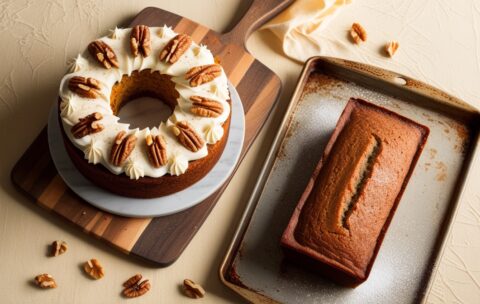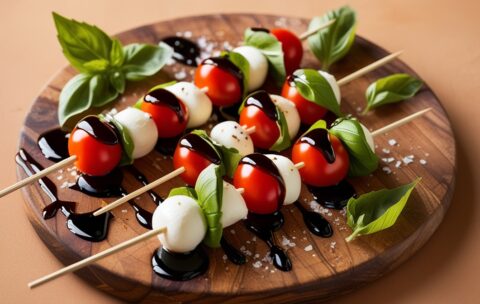Home Update 02
October 4, 2023 2025-06-05 13:04Home Update 02
Become a Home Chef
Learn to cook from scratch and master restaurant-quality meals in your own kitchen. Perfect for beginners and food lovers.

Our Top Courses
We've selected the best programs to get you started. Each course offers step-by-step lessons, hands-on recipes, and guaranteed results — even for beginners.
Cinnamon Sugar–Coated Churro Cake Bites
3 Lessons
4 hours
Intermediate
What you'll learn
How to bake and crumble a base cake optimized for cake bites
Ratio of cake crumbs to filling for ideal texture and binding
Frying vs. baking methods for a golden, light crust
Blending and heating cinnamon-sugar coating for crisp adhesion
Shaping techniques for uniform, crack-free bites
Serving and storage tips to keep bites fresh and crunchy
Passion Fruit and Lychee Tart
7 Lessons
1.8 hour
Intermediate
What you'll learn
How to prepare and blind-bake an almond shortcrust pastry.
Techniques for making a silky smooth passion fruit curd without curdling.
Methods to poach or macerate lychee for optimal flavor and texture.
Assembly steps for layering curd and fruit in the tart shell.
Baking times and temperatures to achieve a crisp crust and set filling.
Creating a glossy fruit glaze to finish and preserve freshness.
Garnishing ideas to elevate presentation (edible flowers, zest, or mint).
Decadent Cheesecakes: From No-Bake to Baked
3 Lessons
1.3 hour
Intermediate
What you'll learn
No-Bake Cheesecake Fundamentals
How to prepare a sturdy, crisp graham cracker (or digestive cookie) crust without baking
Proper gelatin blooming and incorporation techniques for a stable filling
Folding methods to achieve a light, airy texture without deflating whipped cream
Creative topping ideas: fruit compotes, chocolate ganache, caramel drizzle
Baked Cheesecake Mastery
Techniques for preventing cracks: water bath assembly, gentle mixing, and controlled cooling
How to achieve an ultra-creamy, custardy center by managing oven temperature and bake time
Making and baking a fail-proof graham/digestive cookie crust
Flavor variations: lemon zest infusion, pumpkin swirl, poppy seed blends, and espresso accents
Decoration & Presentation
Piping whipped cream rosettes around the rim with a star tip
Arranging fresh fruit in radial patterns and glazing for shine
Adding textured accents: nut crumbles, chocolate shavings, and edible flowers
Troubleshooting & Tips
Solutions for common issues: cracked tops, dense centers, runny fillings, and weeping
Ingredient substitutions (e.g., gluten-free crust options, non-dairy alternatives)
How to scale recipes up or down for 6-inch mini cheesecakes, pie-sized “cheesecake tarts,” or 10-inch party-size
Crispy French Fries
5 Lessons
1.6 hour
Intermediate
What you'll learn
How to choose the ideal potato variety for frying
Techniques for cutting uniform sticks to ensure even cooking
Why soaking and rinsing potatoes removes excess starch
How to dry potatoes properly before frying to achieve crispiness
The double-fry method: temperature control and timing
Seasoning strategies for perfect flavor balance
Tips for storing and reheating fries without losing texture
Mastering Chocolate Cakes
4 Lessons
1.4 hour
Intermediate
What you'll learn
Ingredient Essentials
Understanding Dutch-process vs. natural cocoa
Choosing between all-purpose, cake, and bread flour
Role of oil vs. butter for moisture
Batter Techniques
Creaming method for light layers
One-bowl “melted-chocolate” method for dense cakes
Whipping egg whites for chiffon-style chocolate cake
Baking & Structure
Oven temperature calibration and its impact on rise
Tips for level cakes: pan prep, baking strips, and testing doneness
Troubleshooting: sunken centers, gummy crumbs, uneven tops
Fillings & Frostings
Crafting silky chocolate ganache (TABLE BELOW)
Whipped chocolate buttercream vs. Swiss meringue buttercream
Simple whipped cream and mousse fillings
Decoration & Assembly
Stack and level layers with a cake comb and turntable
Smooth crumb coat, final coat, and ganache drip techniques
Simple piping (star tips) and fresh-fruit accents
Frosting Type Key Ingredients Best Use Case
Chocolate Ganache Equal parts dark chocolate & cream Drip cakes, glossy finishes
Swiss Meringue Buttercream Egg whites, sugar, butter, cocoa Stable layer cakes, rosettes
Whipped Chocolate Buttercream Butter, cocoa powder, powdered sugar, milk Light filling, quick spreads
Decorative Piping & Sugar Flowers
3 Lessons
4.3 hours
Intermediate
What you'll learn
Icing Consistency & Color Blending
Adjusting buttercream and royal icing to the proper firmness for different piping tasks.
Techniques for tinting icing and gum paste to achieve natural, gradient effects.
Piping Basics to Advanced Motifs
Foundational strokes (dots, lines, shells) leading to scrolls, rosettes, ruffles, and lace patterns.
Creating texture, dimension, and contrast through varying pressure, speed, and tip selection.
Sugar Flower Construction
Preparing and conditioning gum paste and fondant for pliability.
Forming petals, leaves, and buds for common flowers (roses, peonies, ranunculus).
Assembling individual elements into realistic bouquets and sprays.
Composition & Placement
Designing balanced cake layouts: focal points, color harmony, and scale.
Securing decorations on tiered and multi-surface cakes without collapse.
Troubleshooting & Finishing Touches
Preventing issues such as cracking, sagging, or color bleeding.
Applying final details: dusting, veining, and edible luster for lifelike appearance.
Stuffed Mushrooms with Herb Cream Cheese
2 Lessons
50 minutes
Intermediate
What you'll learn
How to select and clean the right variety of mushrooms for stuffing (e.g., cremini or button).
Techniques for preparing a smooth, flavorful herb cream cheese filling (including chopping herbs and incorporating garlic).
Properly hollowing and seasoning mushroom caps to maximize flavor absorption.
Baking methods to achieve a golden top and tender mushroom texture without overcooking.
Garnishing tips to add color and contrast (e.g., fresh parsley, red pepper flakes).
Storing and reheating strategies to maintain freshness when making ahead.
Chicken Roulade with Pistachios and Sun-Dried Tomatoes
3 Lessons
3 hours
Intermediate
What you'll learn
How to butterfly and pound chicken breasts for uniform thinness
Techniques for layering and rolling a filled roulade to ensure a tight spiral
Methods for achieving a golden sear and finishing in the oven without drying the chicken
Creating a complementary lemon-herb pan sauce using deglazed fond, white wine, and fresh herbs
Proper slicing and plating to showcase the roulade’s pinwheel cross-section
Louis XIII Pure Gold Cocktail
4 Lessons
2.3 hours
Intermediate
What you'll learn
How to select and handle Louis XIII Cognac to preserve its intricate aromatic profile
Techniques for incorporating edible gold safely and attractively
Crafting a saffron-infused vermouth modifier that enhances, not overpowers, the cognac’s rancio
Proper stirring and dilution to maintain clarity while achieving silky texture
Choosing quality orange bitters and balancing their citric-spice character against the spirit base
Presentation tips: from glass choice to garnish placement for maximal visual impact
Serving temperature guidelines to showcase every nuance of ultra-aged cognac
Caramelized Banana
2 Lessons
2.4 hours
Intermediate
What you'll learn
Banana Selection & Ripeness
How to choose bananas at the peak of sweetness and proper firmness for caramelizing.
Recognizing visual and tactile cues that indicate ideal ripeness.
Caramel Sauce Preparation
Techniques for melting and browning sugar without burning—achieving a smooth, amber-hued caramel.
Balancing sweetness and depth by adjusting cook time and adding flavor enhancers like vanilla or citrus.
Cooking & Coating Bananas
Proper slicing methods to ensure even cooking.
Timing the addition of butter and bananas so the fruit softens without turning mushy.
Tips for gently tossing banana slices in hot caramel to create uniform coating.
Serving & Pairing Ideas
Creative ways to plate caramelized bananas as a standalone dessert or as a component (pancakes, waffles, yogurt, ice cream).
Garnish suggestions—nuts, herbs, spice dustings—to add texture and color contrast.
Storage and make-ahead strategies to preserve caramel’s texture and banana integrity.
Choose Your Category
Our courses are grouped by category to help you find what suits your taste. From quick dinners to gourmet desserts — start with what inspires you.



About Our Culinary Journey
We are passionate about bringing the joy of cooking to everyone. Our mission is to empower food lovers with the skills and confidence to create delicious meals at home. With expert chefs, innovative teaching methods, and a love for culinary arts, we’re here to inspire your kitchen adventures.
Our Commitment
Everyone can cook well. Our courses offer clear guidance to ensure success for all skill levels.
Community Focus
Join our foodie community. Share creations and grow in a supportive environment.
Why Choose Our Culinary Courses?
Our courses are designed to make cooking fun, accessible, and inspiring. Whether you're a beginner or a seasoned cook, our unique features will help you elevate your skills and unleash your culinary creativity.

Expert Instructors
Learn from world-class chefs with years of experience. Our instructors guide you step-by-step, sharing professional tips.

Flexible Learning
Study at your own pace, anytime, anywhere. Our online platform offers 24/7 access to lessons, so you can fit cooking into your busy schedule.

Hands-On Recipes
Practice with real recipes designed for all skill levels. From classic dishes to modern creations, you’ll master meals that impress every time.
What Our
Students Say
Hear from our happy students who have transformed their cooking skills with our courses. From beginners to seasoned cooks, our community loves sharing their success stories!
"This course completely changed how I cook! The instructors are so knowledgeable, and the lessons are easy to follow. I’m now confident making dishes I never thought I could."
Emma Johnson
"I love the flexibility of these courses. I can learn at my own pace and still feel supported. The recipes are amazing, and I’ve impressed my family with new dishes!"
Michael Chen
"The vegan cooking course was a game-changer for me. I learned so many creative ways to make plant-based meals that taste incredible. Highly recommend!"
Sophie Martinez
"The hands-on approach made learning so fun! I went from burning toast to baking artisan bread in weeks. Thank you for such an inspiring experience!"
James Carter
Discover Our Newest Culinary Courses
Get inspired by our latest additions! These exciting courses bring fresh ideas and techniques to your kitchen, perfect for food lovers eager to try something new. Browse our carousel to find your next culinary adventure.
Salmon Confit on Baby Spinach
4 Lessons
1.4 hour
Intermediate
What you'll learn
How to choose high-quality salmon for confit (fresh-fish selection, portion sizes)
Steps to prepare the poaching oil with aromatics (garlic, thyme, citrus)
Technique for gently poaching salmon at a precise low temperature (175–185 °F / 80–85 °C)
Preparing baby spinach with a light lemon-mustard vinaigrette (emulsion basics)
Methods for plating so the salmon and spinach complement each other visually and texturally
Cobb Salad
6 Lessons
2.9 hours
Intermediate
What you'll learn
How to poach or grill chicken breast for optimal juiciness
Technique for rendering and crisping bacon
Proper avocado selection and slicing without browning
Making a balanced Dijon-honey vinaigrette
Layering and plating the salad for visual appeal
Variations to adapt to dietary preferences (vegetarian, gluten-free)
Niçoise Salad
3 Lessons
3.5 hours
Intermediate
What you'll learn
How to cook baby potatoes to a tender yet firm “bite”
Blanching haricot verts (thin green beans) for vibrant color and snap
Properly searing fresh tuna (or preparing high-quality canned tuna)
Crafting a classic Dijon-vinaigrette with shallots and garlic
Composing and plating a balanced, restaurant-style Niçoise
Crêpe Suzette
3 Lessons
3.3 hours
Intermediate
What you'll learn
Techniques for cooking crêpes evenly in a nonstick pan (temperature control, batter spread).
Steps to prepare an aromatic orange–butter sauce with fresh citrus zest and juice.
Proper method of adding liqueur and safely flambéing to develop caramelized notes.
Plating and folding options that highlight the vibrant orange sauce.
Tips for timing so crêpes remain warm and supple when served.
Ingredient substitutions (e.g., Cointreau or Grand Marnier, using mandarin or tangerine zest).
Moscow Mule
5 Lessons
1.7 hour
Intermediate
What you'll learn
Historical Background: Discover how the Moscow Mule emerged in post–World War II America and its role in boosting vodka’s popularity.
Ingredient Selection: Learn why a quality vodka and spicy, carbonated ginger beer make a difference, and how fresh lime juice elevates the drink.
Proportions & Balance: Master the classic ratio of vodka to ginger beer to lime, ensuring the right interplay of heat, acidity, and spirit.
Mixing Technique: Practice stirring versus brief shaking to preserve carbonation, and understand why crushed ice versus cubes can alter texture.
Presentation & Serving: Explore the tradition of using a copper mug—how it impacts temperature, aroma, and visual appeal.
Garnishing & Variations: Experiment with garnish choices (lime wheel, mint sprig, candied ginger) and creative twists (fruit infusions, flavored vodkas).
Tasting & Pairing: Develop your palate to identify the balance between ginger spice and lime acidity, and which foods complement the Mule’s zing.
Paella Valenciana
2 Lessons
3.3 hours
Intermediate
What you'll learn
History and Regional Context
Origins of Paella Valenciana and its connections to Valencian agricultural traditions.
Distinctions between classic Valencian paella, seafood paella (Paella de Mariscos), and other regional variants.
Selecting and Preparing Ingredients
Rice varieties (Bomba vs. Calasparra) and their impact on texture.
Choosing quality proteins (chicken and/or rabbit), native beans (judía verde, garrafó), olive oil, and saffron threads.
Preparing vegetables: green beans (bajoqueta), garrafó beans, fresh tomatoes, and garlic.
Cooking Techniques and Timing
Building a sofrito base: sautéing meat, vegetables, and spices to develop depth of flavor.
Proper rice-to-liquid ratio and how to incorporate stock infused with saffron.
Achieving the prized socarrat (crispy rice crust) without burning.
Adjusting heat levels for even cooking and optimal moisture absorption.
Presentation and Serving
Traditional ways to serve Paella Valenciana—family style straight from the paellera.
Garnishing options (lemon wedges, fresh parsley) to enhance aroma and appearance.
Tips for reheating and storing leftovers without compromising texture.
Mojito
3 Lessons
2.3 hours
Intermediate
What you'll learn
How to properly muddle mint and sugar to release essential oils without bruising the leaves.
The ideal ratio of white rum, fresh lime juice, and simple syrup for a perfectly balanced drink.
Techniques for layering ingredients and adding soda water to preserve carbonation.
Tips for selecting the freshest mint varieties and hand-rolling or tearing leaves.
Methods to crush ice at home for that classic “frosty” Mojito texture.
Variations on the traditional recipe, including flavored syrups or fruit additions.
Mastering Chocolate Cakes
4 Lessons
1.4 hour
Intermediate
What you'll learn
Ingredient Essentials
Understanding Dutch-process vs. natural cocoa
Choosing between all-purpose, cake, and bread flour
Role of oil vs. butter for moisture
Batter Techniques
Creaming method for light layers
One-bowl “melted-chocolate” method for dense cakes
Whipping egg whites for chiffon-style chocolate cake
Baking & Structure
Oven temperature calibration and its impact on rise
Tips for level cakes: pan prep, baking strips, and testing doneness
Troubleshooting: sunken centers, gummy crumbs, uneven tops
Fillings & Frostings
Crafting silky chocolate ganache (TABLE BELOW)
Whipped chocolate buttercream vs. Swiss meringue buttercream
Simple whipped cream and mousse fillings
Decoration & Assembly
Stack and level layers with a cake comb and turntable
Smooth crumb coat, final coat, and ganache drip techniques
Simple piping (star tips) and fresh-fruit accents
Frosting Type Key Ingredients Best Use Case
Chocolate Ganache Equal parts dark chocolate & cream Drip cakes, glossy finishes
Swiss Meringue Buttercream Egg whites, sugar, butter, cocoa Stable layer cakes, rosettes
Whipped Chocolate Buttercream Butter, cocoa powder, powdered sugar, milk Light filling, quick spreads
Carrot Cake & Spiced Loaf Cakes
2 Lessons
2.2 hours
Intermediate
What you'll learn
How to grate carrots (or prepare alternative base ingredients) to achieve ideal moisture and texture
Techniques for toasting nuts and folding mix-ins to prevent a heavy crumb
Spice blending ratios for cinnamon, nutmeg, ginger, and cloves to balance warmth and sweetness
Methods to cream butter and sugar just enough—no overmixing—so loaves rise evenly without tunnels
Frosting options: crafting classic cream cheese frosting, drizzling brown butter glaze, and applying a neat powdered sugar dusting
Variations on the base recipe (apple-spice, pumpkin-spice, coconut-carrot) to adapt to seasonal ingredients
Caprese Skewers with Balsamic Glaze
4 Lessons
1.8 hour
Intermediate
What you'll learn
Selecting and preparing ripe cherry tomatoes, fresh basil, and high-quality mozzarella for optimal flavor.
Assembling skewers with balanced proportions to ensure each bite features tomato, cheese, and basil.
Creating a silky balsamic glaze by reducing balsamic vinegar to the perfect viscosity.
Techniques for drizzling glaze artistically for presentation.
Storing and transporting assembled skewers without compromising texture or appearance.
Flavor pairing suggestions (e.g., adding a sprinkle of sea salt, cracked pepper, or a drizzle of olive oil).




